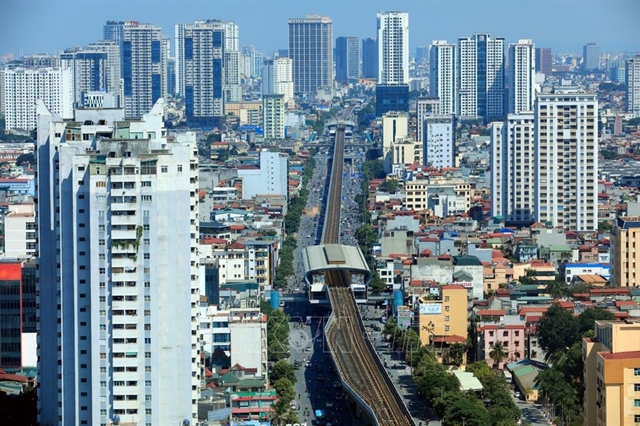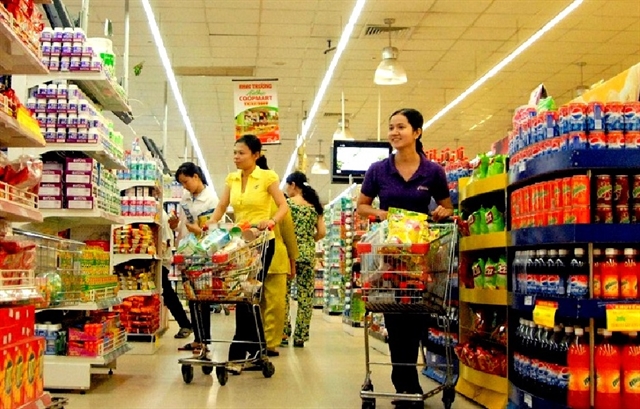 Economy
Economy


|
| A supermarket in Hà Nội. Viêt Nam’s CPI in September increased by 2.61 per cent compared to December 2024. —Photo chinhphu.vn |
HÀ NỘI — Việt Nam’s consumer price index (CPI) maintained its upward trajectory in September, rising by 0.42 per cent compared to the previous month, according to the National Statistics Office (NSO).
Speaking at a press conference on October 6 to announce the country’s socio-economic performance in Q3 and the first nine months of the year, NSO Director Nguyễn Thị Hương said that September’s CPI increased by 2.61 per cent compared to December 2024 and by 3.38 per cent year-on-year.
The average CPI in Q3 2025 rose by 3.27 per cent over the same period last year — the same rate of increase recorded for the first nine months of 2025.
Hương also highlighted the Government’s ongoing efforts to simplify administrative procedures, streamline management structures and create favourable conditions for business and production.
She noted that authorities had implemented a range of coordinated solutions to manage prices and balance supply and demand, aiming to control inflation while maintaining economic recovery momentum.
Key initiatives included stabilising the foreign exchange market, reducing lending interest rates, accelerating public investment disbursement, cutting taxes and fees, lowering environmental protection taxes on gasoline and oil and promoting technological innovation and market links.
According to the NSO, the CPI increased in eight out of the first nine months of 2025, influenced by both domestic and global factors — including seasonal demand during holidays and Tết (Lunar New Year), as well as international price fluctuations in commodities such as rice, fuel and cooking gas.
January recorded the highest monthly increase at 0.98 per cent, driven by rising demand during the Lunar New Year holiday and adjustments in medical service fees in some localities.
February saw a 0.34 per cent increase, largely due to rising pork and rental housing prices as workers returned to urban areas after Tết.
March was the only month with a CPI decline, dropping 0.03 per cent due to lower prices for rice and gasoline.
From April to September, CPI rose steadily, by between 0.05 per cent and 0.48 per cent, largely reflecting increased costs for housing, dining out, electricity, education and home maintenance materials.
On average, the monthly CPI increase during the first nine months of 2025 stood at 0.29 per cent.
Key contributors to inflation
The NSO attributed the CPI increase to several key drivers: healthcare, housing and utilities, food and catering services, and education.
In terms of healthcare, medical service prices surged following the Ministry of Health’s Circular 21/2024/TT-BYT, contributing to a 13.48 per cent increase in the price index for medicine and healthcare services.
Meanwhile, prices for housing, electricity, water, fuel and construction materials rose by 6.14 per cent, with household electricity costs climbing 7.05 per cent after price adjustments in October 2024 and May 2025.
Food and catering services saw a 3.3 per cent increase, with pork prices significantly impacting the 3.59 per cent rise in food prices and 3.72 per cent increase in the cost of eating out.
Adjusted tuition fees for the 2025–2026 academic year led to a 1.81 per cent increase in the education price index.
At the same time, a 5.37 per cent rise was observed in the price index for various goods and services, including notary services, insurance and personal services like weddings and funerals.
In contrast, some groups recorded price declines. Notably, the transportation index fell by 2.9 per cent due to lower fuel prices, and the post and telecommunications index dipped 0.47 per cent, primarily due to falling prices for older mobile phone models.
Core inflation, which excludes volatile items like food, fuel and Government-regulated services, rose by 0.2 per cent in September compared to August and increased by 3.18 per cent year-on-year.
For the first nine months of 2025, core inflation averaged 3.19 per cent, slightly lower than the headline CPI growth rate of 3.27 per cent.
Hương noted that inflation remained under control, but warned of potential price increases in October due to the impact of recent storms, which were expected to push up the cost of green vegetables, seafood and processed foods.
The NSO also reported significant fluctuations in domestic gold prices in line with global trends. As of September 29, the average global gold price had reached US$3,688.38 per ounce, up 7.9 per cent from the previous month.
The surge was attributed to the US Federal Reserve (Fed)'s interest rate cut on September 17, which weakened the dollar and boosted gold’s appeal as a safe-haven asset amid rising geopolitical tensions and inflation concerns.
On the domestic front, gold prices in September increased by 6.53 per cent month-on-month and 55.4 per cent year-on-year. The average price of gold for the first nine months of 2025 rose by 41.86 per cent compared to the same period last year.
As for the price of US dollars in Việt Nam, the trend contrasted with the global market. As of September 29, the US Dollar Index on the international market was down 0.65 per cent from the previous month.
This decline was mainly due to the Fed's interest rate cut, which reduced the attractiveness of the dollar compared to other major currencies.
Domestically, however, the US dollar price in September rose by 0.3 per cent month-on-month. This increase was driven by higher demand for foreign currency to support import activities, as well as psychological factors - with many people choosing to hold US dollars amid the State Bank’s move to ease monetary policy.
The price of US dollars during the first nine months of 2025 surged by 6.64 per cent year-on-year. — VNS




